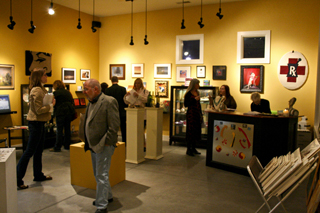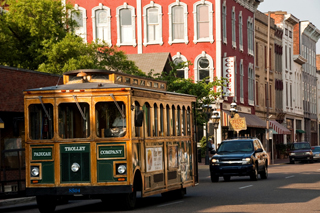 |
 |
The Story of Paducah, Kentucky A National Trust for Historic Preservation Main Street City is the model for revitalization by recruiting and welcoming visual artists from across the nation to assist in their goals. Paducah town officials, tourism executives, shop proprietors, and gallery owners had the wisdom and foresight to understand the benefits of a an innovative collaboration in which artists are embraced, nurtured, and respected for their ideas, talent, and contributions. 
If you want to see Paducah’s citizens cringe, call Paducah a “sleepy little river town”. The truth is that Paducah is far from sleepy. Yes, it’s located on the Ohio River, and its population is a little more than 25,000. However, Paducah offers arts and cultural outlets that rival what can be found in much larger cities, and I mean much, much larger cities. It’s not uncommon to have simultaneous weekend events at the Luther F. Carson Four Rivers Performing Arts Center, Maiden Alley Cinema, and Market House Theatre. Don’t forget the excitement of gallery showings and workshops at the dozens of art galleries in LowerTown and music, food, and entertainment Saturday nights with Live on Broadway. Sprinkle in the unique museums such as the National Quilt Museum of the United States and the River Discovery Center, and you have a city that laughs at the phrase “sleepy little river town”. But Paducah’s story could have been very different. Beginning in the 1800s, Paducah and its downtown thrived for decades due to its port facilities. Paducah is uniquely situated at the confluence of the Ohio and Tennessee Rivers. The City capitalized on its geographic location by offering port and docking facilities and many successful support industries. Paducah survived ups and downs in the river industry. However, one of the biggest changes for Paducah occurred in the 20th century with the construction of an interstate. Interstate-24 loops around the outer edge of Paducah. The development of a mall in the early 1980s and the influx of big retail chains lured business traffic away from the downtown area leading to many empty storefronts. In a short time, the negligence of downtown Paducah led to a high crime rate and vacant buildings. This would mean the end of the line for many downtowns, succumbing to flashy malls and big box stores. However, a small group of neighborhood residents, business owners, and property owners had a different idea for downtown Paducah. In 1989, Paducah Main Street was born. The strong group of residents and business and property owners gained the City’s support to apply for the Main Street Program. The program has flourished since 1989, and in 2010 Paducah received a Great American Main Street Award through the National Trust for Historic Preservation. In the 1990s, Paducah focused on revitalizing its downtown through ridding the neighborhood of crime, embarking on streetscape projects, restoring historic buildings, and making downtown a destination once again. In 2004, the community opened the doors of the state-of-the-art Luther F. Carson Four Rivers Performing Arts Center. The Carson Center brings Broadway shows to Paducah and provides a performance venue for the Paducah Symphony Orchestra. Many cities would puff their chests and shout their successes from the rooftops. With a bustling downtown and a glittery performing arts center, what more could one city ask. It’s time to sit back and reaps the rewards. But Paducah wasn’t just focused on downtown. It was also looking at a neighborhood adjacent to downtown known as LowerTown. LowerTown is one of Paducah’s oldest residential neighborhoods. In 1836, the Kentucky State Legislature passed an amendatory act which annexed to Paducah an area from Jefferson Street to Clay Street from the Ohio River to 9th Street. This addition was called “LowerTown” because it was downstream from Paducah’s commercial area. The area remained a prominent neighborhood for decades and was the home of mayors of Paducah, bank presidents, factory owners, lawyers, and physicians. The neighborhood is full of Greek Revival and Italianate home styles. In 1982, the neighborhood was recognized by the federal government for its historical and architectural significance and listed in the National Register for Historic Places. It sounds like a wonderful place, but in the 1980s the neighborhood began to change with many of the large homes divided into apartments, an influx of crime and poverty, and a general neglect of the structures. In 2000, an artist living in LowerTown, Mark Barone, witnessed a drug deal in his neighborhood. He then had an idea of bringing artists to town in hopes of saving the neighborhood. Taking his idea to the City of Paducah’s then Planning Director, Tom Barnett, the two joined forces to develop the Artist Relocation Project. In 2001, the City of Paducah initiated meetings between the City and the newly invigorated LowerTown Neighborhood Association, neighborhood residents, as well as other stakeholders. The City Commission developed a strategic plan determining that Vital Neighborhoods was of the four primary goals established by the City to meet within five years. A LowerTown Plan was drafted and approved in 2002 setting the stage for the incentive program and the inviting of artists from across the nation to Paducah. The plan included a local bank, Paducah Bank, offering no-down-payment, low interest loans for the full cost of buying and restoring the property, a bold move by the bank since that often meant loaning much more than the appraised value of the home. The City of Paducah also purchased dilapidated homes and sold them for as little as a $1.00 to the artists. To combat the crime, the Paducah Police Department targeted the neighborhood cutting the crime rate in half. In the decade since the beginning of the Artist Relocation Program, dozens of artists from all across the nation have moved to Paducah, renovated a historic home, and opened a gallery. Yes, some of the artists have moved on to different cities. But each artist contributes to the neighborhood, adds their own creative touch, and if an artist decides to transfer, he or she undoubtedly leaves the neighborhood in a better shape than when they found it. With marketing efforts by various entities such as the Convention and Visitors Bureau, the City of Paducah, and Paducah Renaissance Alliance (PRA), the neighborhood has become a tourist destination. On the second Saturday of the month, galleries extend their hours of operation, welcoming tourists and curious residents. The artists use various venues such as local restaurants and art centers to showcase their work. PRA organizes an annual event called the Affordable Art Show to make sure that everyone can purchase a beautiful creation by local artists. Although a tiny percentage of the population of the City of Paducah, the artists are one of the most visible and vocal groups. 
You may think that Paducah can finally sit back and enjoy its successes since it has national recognition as an artist community with a program that is the envy of many other cities. But that would be uncharacteristic of Paducah. LowerTown, downtown, and the riverfront area are known as the Renaissance Area. Paducah is embarking on improving and uniting the entire area through initiatives outlined in the Renaissance Area Master Plan. The plan still is in its infancy. But if history repeats itself, Paducah’s residents will have some new successes to boast about in the near future. Written by Pam Spencer, Publication Information Officer for the City of Paducah.
© Copyright 2012 Preserve America |